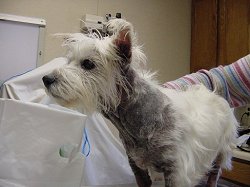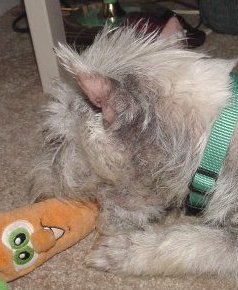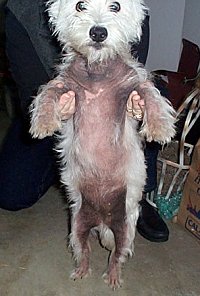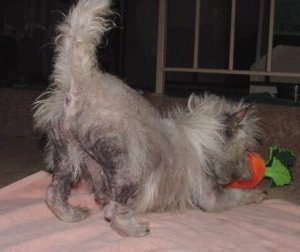Malassezia Dermatitis
(Yeast infection of the skin)
|
The information contained in this article is for informational purposes only
and is not meant to be a substitute for the advice provided by your own
veterinarian. You should not use the information contained herein for diagnosing
the health of a Westie - you should always consult your own veterinarian.
|

Over the last several years, an alarming number of Westie owners have been
seeking assistance for their Westies that are suffering from the troublesome
condition of Malassezia dermatitis.
Despite countless visits to their veterinarian and an assortment of
medications, their Westie’s condition just gets worse and worse. As a result,
the owner becomes more and more frustrated and, all too often, the Westie ends
up being abandoned at the vet’s office, relinquished to a shelter or rescue
group, or euthanized.
Most often, the inquiry is a desperate plea similar to the following: "I
own a Westie with severe skin allergies. We have been to the vet on numerous
occasions and tried all sorts of medications, but nothing is working. My Westie
is constantly itching and losing its hair. I feel so bad for him/her. Do you
have any suggestions for what I can do to help him/her?"
Does this sound familiar? Is your Westie suffering from itching, hair loss,
black oily skin and/or crusty skin, a musty/yeasty odor, and usually accompanied
by an ear infection?
If your response is "yes," than it is quite possible that your
Westie has Malassezia.
Yeast infections are especially itchy, crusty, and smelly. Often the Westie
starts with a rash or a simple itching, and the skin may begin to thicken to an
"elephant-like" skin appearance. The itch gets extreme, and the odor
can become especially troublesome.
What is Malassezia?
 Malassezia is the name of a type of yeast (fungus) that is found on both
normal and abnormal canine skin and ears. On normal healthy skin, it causes no
problems. To get a yeast infection, conditions on the skin surface have to
change to favor the proliferation of the yeasts. Some conditions which could
lead to a yeast proliferation include: high environmental humidity, an increase in
skin oils (from an allergic flare up), an immune deficiency, flea, airborne and/or food
allergies, or seborrhea (excessive oil production of the skin). Some Westies are
actually allergic to the yeasts themselves.
Malassezia is the name of a type of yeast (fungus) that is found on both
normal and abnormal canine skin and ears. On normal healthy skin, it causes no
problems. To get a yeast infection, conditions on the skin surface have to
change to favor the proliferation of the yeasts. Some conditions which could
lead to a yeast proliferation include: high environmental humidity, an increase in
skin oils (from an allergic flare up), an immune deficiency, flea, airborne and/or food
allergies, or seborrhea (excessive oil production of the skin). Some Westies are
actually allergic to the yeasts themselves.
There are a number of breeds predisposed genetically to yeast infections;
unfortunately, the West Highland White Terrier is one of them.
How is a Malassezia infection diagnosed?
 The most common way to diagnose Malassezia is with a positive
identification of the organism under the microscope. Your veterinarian can take
a microscope slide and press it onto the affected area, then the sticky, oily
stuff that clings to the slide can be stained and examined for the organism.
Other methods your vet may use include collecting the material with a cotton
swab or scraping the skin and applying it to the slide. However, because Malassezia is a common resident of normal skin of dogs and cats, there may always be some doubt as to if it is the causative agent of the symptoms. Therefore, diagnosis is usually confirmed by response to treatment. (Please note: A Staph infection can have very similar symptoms as Malassezia...loss of hair, bad odor, etc. When your veterinarian takes the slide, if the yeast organism is found, it could be Malassezia; if a bacteria organism is found, it could be Staph. Treatment of Staph is very similar. Always consult with your veterinarian.) The most common way to diagnose Malassezia is with a positive
identification of the organism under the microscope. Your veterinarian can take
a microscope slide and press it onto the affected area, then the sticky, oily
stuff that clings to the slide can be stained and examined for the organism.
Other methods your vet may use include collecting the material with a cotton
swab or scraping the skin and applying it to the slide. However, because Malassezia is a common resident of normal skin of dogs and cats, there may always be some doubt as to if it is the causative agent of the symptoms. Therefore, diagnosis is usually confirmed by response to treatment. (Please note: A Staph infection can have very similar symptoms as Malassezia...loss of hair, bad odor, etc. When your veterinarian takes the slide, if the yeast organism is found, it could be Malassezia; if a bacteria organism is found, it could be Staph. Treatment of Staph is very similar. Always consult with your veterinarian.)
It is important to note that before a primary diagnosis of Malassezia
is rendered, other conditions should be ruled out. Allergies to contacted
surfaces, reactions to medications, skin infections (like mange), and atopy
(food allergy) may cause similar symptoms. The goal is to determine if Malassezia is the primary problem or is occurring secondary to another condition. In either case, the yeast infection must be cleared up.
It is also important to note that yeast infections are not contagious;
however, they can recur if the underlying allergy, seborrhea, etc., is not
controlled.
How are Malassezia infections treated?
 Treatment can be oral, topical, or both. Topical treatment alone is not usually adequate, but since oral medications are expensive, often topical management alone is
attempted first, especially if only a small body area is involved. (For localized treatment of very small areas, miconazole cream can be applied twice daily for several weeks.) Treatment can be oral, topical, or both. Topical treatment alone is not usually adequate, but since oral medications are expensive, often topical management alone is
attempted first, especially if only a small body area is involved. (For localized treatment of very small areas, miconazole cream can be applied twice daily for several weeks.)
To provide an inhospitable environment for Malassezia, lipids on the
skin need to be removed. There are specifically anti-yeast shampoos such as
Malaseb available
from your vet or easily found at many online stores, Nizoral obtainable over-the-counter at drug stores, and Micro-Tek
medicated shampoo (a combination anti-bacterial, anti-fungal, and anti-microbial product available through
www.valleyvet.com).
The Westie must be bathed twice a week to start for several weeks. The
shampoo should remain lathered on the skin for 10-15 minutes before rinsing.
Occasionally, the Westie may become pruritic after topical treatment. This is
not a reaction to the shampoo, but more likely it reflects the release of the
toxin zymogen from the yeast cell wall as the organisms die. This
reaction will resolve as the infection is eliminated. As the condition improves,
the Westie should be bathed once a week for several more weeks or until the skin
is clear. Leave on conditioners such as ResiCort and ResiChlor (available from
your vet or via mail order - the least expensive we’ve found is at
www.upco.com) have also proven to be of some benefit in some cases.
For dogs with more severe cases, or those cases which are resistant to
topical treatment, oral Ketoconazole (brand name: Nizoral) can be administered
for several weeks (in addition to the baths). A response is generally seen
within 1-2 weeks, but therapy needs to continue for an additional 3-6 weeks.
Ketoconazole is very effective, but because of its potentially toxic side
effects and expense, it should only be used under direct veterinary supervision.
 Please note: Malassezia responds poorly to prednisone, and it
should not be used as the main treatment. However, depending on the severity of
any internal swelling the Westie may be experiencing, a cortisone shot and/or a
short course of prednisone may be helpful in getting the Westie on the right
road to recovery. Please note: Malassezia responds poorly to prednisone, and it
should not be used as the main treatment. However, depending on the severity of
any internal swelling the Westie may be experiencing, a cortisone shot and/or a
short course of prednisone may be helpful in getting the Westie on the right
road to recovery.
How Ketoconazole works
Ketoconazole works by interfering with the structure of the fungal cell wall.
Depending on the fungus and depending on the dose used, Ketoconazole may kill
the fungus or just inhibit its ability to reproduce.
The most common side effects are nausea, vomiting, and diarrhea. These may be
reduced by giving Ketoconazole with food or by dividing the dose into several
smaller doses (we normally use ½ or ¼ tablet twice a day - depending on the
severity of the condition). If nausea is severe, it should resolve with
discontinuation of the medication.
It is best to avoid using Ketoconazole in patients with pre-existing liver
disease or with decreased platelet (blood clotting cell) levels. When
Ketoconozole therapy will continue for months at a time, many veterinarians will
monitor liver enzymes and complete blood counts. (Contraindications: Imadazole
antifungal drugs have been associated with life-threatening cardiac arrhythmias
in man when administered concomitantly with certain antihistamines. Accordingly, we prefer to avoid using any
antihistamines while the Ketoconozole is being given.)
Note: Ketoconozole is an expensive "human" medication and, while some vets stock it, sometimes it must be obtained from your neighborhood or online mail order pharmacy. The least expensive place we have found it to date is via mail order from Costco (www.costco.com).
Atopica® or Gengraf® (generic: Cyclosporine)
Malassezia may be triggered by Atopic dermatitis, an underlying allergy to
common airborne allergens such as pollens, molds and dust mites. Atopic
dermatitis is the most common allergic skin disease in dogs. The disease
is chronic and lasts a lifetime. It is almost impossible to completely
avoid allergens, so most Atopic dogs need long-term treatment.
Atopica® or Gengraf® (Cyclosporine oral capsules) is
effective in controlling Atopic dermatitis by selectively targeting specific
immune cells responsible for the dog’s allergic response. Atopic
dermatitis can not be cured but it can be successfully managed with this
medication.
As with all drugs, side effects may occur. The most
common side effect is gastrointestinal upset. Please consult with your
veterinarian or veterinary dermatologist to determine if Atopica® or Gengraf® (Cyclosporine) is appropriate
for your Westie.
Ear Care
Ear infections or otitis externa, is often a mixed infection involving yeast,
bacteria and, at times, ear mites. If an infection develops in the ear, the dog
may shake his head and scratch at his ears. There may also be a foul odor from
the ear.
Zymox Otic Pet Ear Treatment with Hydrocortisone can be ordered
over-the-counter through
Amazon.com
Otomax Ointment requires a veterinary prescription and is
available online or through your veterinarian's office.
The following links will take you to examples of actual cases and photographs of Westies which have been treated for Malassezia. Please note: These cases should be used for example purposes only. Each individual Westie should have a treatment program tailored especially for that Westie depending on the severity of the Malassezia and the Westie’s overall condition of health:
MALASSEZIA IS NOT CONTAGIOUS
References:
Veterinarian Information Network, Inc.
(www.vin.com)
American College of Veterinary Dermatology (www.acvd.org) Drs. Foster & Smith, Inc.
(www.peteducation.com)
VetCentric (www.vetcentric.com)
University of Prince Edward, Canine Inherited Disorders
Database (www.upei.ca~cidd)
The Westie Foundation of America, Inc. Newsletter
(www.westiefoundation.org)
Also see:
Atopica - by
Novartis Gengraf - by Abbott
Laboratories
|